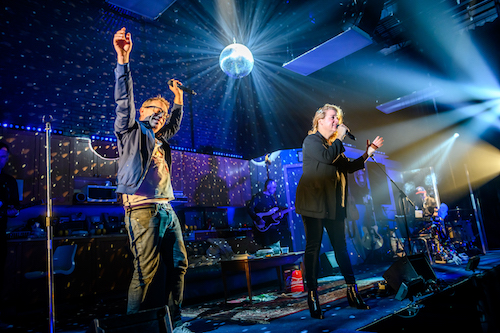 Meta-play and concert celebrates and explores the 20-year legacy of indie band Stars
Meta-play and concert celebrates and explores the 20-year legacy of indie band Stars
Montreal’s indie-rock darlings Stars are celebrating their 20th year of making music by starring in a play about themselves at Streetcar Crowsnest. Stars: Together, a combination “rock-doc” and concert, is a self-aware piece, created by the band, Chris Abraham, and Zack Russell. It combines Behind the Music-style drama and metatheatre to form something a little weird and a little wonderful.
I’m a very casual fan of Stars – I’ve enjoyed their music, but never sought it out, and couldn’t name all eight of their albums. For true fans of the band, this show is a no-brainer, but it’s not just a concert, and can be enjoyed on both a theatrical and musical level.
The band, particularly its backing members, are not professional actors – and that’s okay. They put us at ease with what feel like honest speeches about past theatre traumas and their discomfort with the show, which self-consciously airs their dirty laundry and dysfunction. There is constant fighting, particularly with the volatile co-lead Torquil Campbell, who is prone to anger, depression, and college student-style rants about capitalism. The bank accounts are dry, they’ve been fired by their manager, and long-standing romantic conflicts still linger. Everyone is frustrated with the endless routine, but unwilling to come to an ending.
Each band member has at least one showcase monologue, but Campbell and frontwoman Amy Millan come to the front here as well. Campbell is the most intense of the bunch, and also the most frustrating; beginning with a screed over theatre that moralizes, he naturally spends the rest of the show moralizing. Because we’re on a knife’s edge of metatheatre, it’s never quite clear how much he’s performing; even his vulnerability seemed performative, asking us to come in but pushing us away. Millan does the emotional labour for all the grown men in the group, and it’s a treat to see her frustration come to a head. Her husband, Evan Crawley, has an interesting take on memory loss that becomes thematically significant.
Set designer Ken MacKenzie has built what I can imagine to be a faithful recreation of the band’s Montreal apartment: practice space in all its messy glory and added a glowing, mysterious closet, and a catwalk running into the audience. The set lends itself to decent recurring sight and audio gags, such as an ever-breaking coat rack and exaggerated stomping motions to justify the echoing noises in the stairwell. MacKenzie also gives us rock concert lighting and stage haze for the moments when the group performs and everything else falls away.
Other visuals are a little less successful. The band is bookended by two large human-form industrial-frame puppets (Zach Fraser) with projected-on human faces, whose vaguely menacing appearance produced warring reactions of sympathy and discomfort from my guest and myself, a kind of “Uncanny Valley of Misfit Toys.” The puppets, perhaps, spoke to the out-of-body effect that performance and self-doubt can have. They also illustrated some of the songs that were clearly outside of the show’s narrative. However, they’re aesthetically jarring, and ultimately don’t add a lot beyond body horror.
The relatively even balance of book and music surprised me, rather than the dialogue serving as interstitial connections between songs. I found myself wanting even more musical numbers, the highlight of the show, particularly because there’s no attempt to jam them in, jukebox musical-style.
Instead, they exist to emphasize the previous scene’s emotional resonance, and to give us a hell of a show – we really see what draws the band together in the moments they perform: the ability to expand into something larger than life, as Campbell explains in an earlier monologue about his love of the art. Of course, the ability of music to transport us can be positive or negative, and there’s a thoughtful segment dealing with whether artists are responsible for how fans interpret their work.
While I appreciated the atmospheric use of the songs, introducing some of them with a secondary story about two unrelated individuals felt less relevant than what else was going on onstage, and this probably could have just been tweaked to relate more closely to the band.
The first act, which builds the band’s dynamics, flirts with cliché, but is saved by the charisma of the performers and the music. The second half becomes more satisfying, picking up dropped threads from the beginning that emphasize the cyclical nature of breaking up and getting back together, creation and renewal. Connections are made and connections fade, and there’s even an entertaining celebrity cameo. Other moments, like a symbolically forgotten tea in the microwave, seemed portentous but were abandoned, and I wished they had cycled back again. Purposefully, there’s no clear resolution, inviting the audience to embrace the fragility, and possible futility, of a life that’s at least one lived together.
Though I’m not sure if my nerves could take being a member of this tumultuous band, I definitely left as more of a fan than I was before. If you’re a Stars acolyte, what are you waiting for? If you’re not, now’s your chance.
Details
- Stars: Together plays at the Streetcar Crowsnest Guloien Theatre (345 Carlaw Ave.) until December 15, 2019.
- Shows run Tuesday-Saturday at 8:00 PM and Wednesday, Saturday and Sunday at 2:00PM.
- Tickets are $30-70 and can be purchased online, by calling (647) 341-7390 ext. 1010, or in person at the Theatre Box Office.
- The show is approximately 2 hours and 10 minutes with intermission, and involves stage fog and haze, and mature language.
